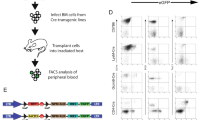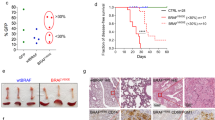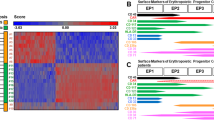Abstract
The Friend virus susceptibility 2 (Fv2) locus encodes a dominant host factor that confers susceptibility to Friend virus-induced erythroleukaemia in mice. We mapped Fv2 to a 1.0-Mb interval that also contained the gene (Ron) encoding the stem cell kinase receptor (Stk). A truncated form of Stk (Sf-stk), which was the most abundant form of Stk in Fv2-sensitive (Fv2ss) erythroid cells, was not expressed in Fv2 resistant (Fv2rr) cells. Enforced expression of Sf-stk conferred susceptibility to Friend disease, whereas targeted disruption of Ron caused resistance. We conclude that the Fv2 locus encodes Ron, and that a naturally expressed, truncated form of Stk confers susceptibility to Friend virus-induced erythroleukaemia.
This is a preview of subscription content, access via your institution
Access options
Subscribe to this journal
Receive 12 print issues and online access
$209.00 per year
only $17.42 per issue
Buy this article
- Purchase on Springer Link
- Instant access to full article PDF
Prices may be subject to local taxes which are calculated during checkout





Similar content being viewed by others
References
Friend, C. Cell-free transmission in adult swiss mice of a disease having the character of a leukemia. J. Exp. Med. 105, 307– 318 (1956).
Axelrad, A.A. & Steeves, R.A. Assay for Friend leukemia virus: rapid quantitative method based on enumeration of macroscopic spleen foci in mice. Virology 24, 513– 518 (1964).
Mager, D., MacDonald, M.E., Robson, I.B., Mak, T.W. & Bernstein, A. Clonal analysis of the late stages of erythroleukemia induced by two distinct strains of Friend leukemia virus. Mol. Cell. Biol. 1, 721– 730 (1981).
Moreau-Gachelin, F., Tavitian, A. & Tambourin, P. Spi-1 is a putative oncogene in virally induced murine erythroleukaemias. Nature 331, 277– 280 (1988).
Mowat, M., Cheng, A., Kimura, N., Bernstein, A. & Benchimol, S. Rearrangements of the cellular p53 gene in erythroleukaemic cells transformed by Friend virus. Nature 314, 633–636 (1985).
Ben-David, Y. & Bernstein, A. Friend virus-induced erythroleukemia and the multistage nature of cancer. Cell 66, 831–834 (1991).
Steeves, R.A. Editorial: spleen focus-forming virus in Friend and Rauscher leukemia virus preparations. J. Natl Cancer Inst. 54, 289 –297 (1975).
Wolff, L. & Ruscetti, S. Malignant transformation of erythroid cells in vivo by introduction of a nonreplicating retrovirus vector. Science 228, 1549–1552 ( 1985).
Berger, S.A., Sanderson, N., Bernstein, A. & Hankins, W.D. Induction of the early stages of Friend erythroleukemia with helper-free Friend spleen focus-forming virus. Proc. Natl Acad. Sci. USA 82, 6913–6917 (1985).
Clark, S.P. & Mak, T.W. Complete nucleotide sequence of an infectious clone of Friend spleen focus-forming provirus: gp55 is an envelope fusion glycoprotein. Proc. Natl Acad. Sci. USA 80, 5037–5041 (1983).
Amanuma, H., Katori, A., Obata, M., Sagata, N. & Ikawa, Y. Complete nucleotide sequence of the gene for the specific glycoprotein (gp55) of Friend spleen focus-forming virus. Proc. Natl Acad. Sci. USA 80, 3913–3917 (1983).
Aizawa, S. et al. Env-derived gp55 gene of Friend spleen focus-forming virus specifically induces neoplastic proliferation of erythroid progenitor cells. EMBO J. 9, 2107–2116 (1990).
Kabat, D. Molecular biology of Friend viral erythroleukemia. Curr. Top. Microbiol. Immunol. 148, 1–42 ( 1989).
Li, J.P., D'Andrea, A.D., Lodish, H.F. & Baltimore, D. Activation of cell growth by binding of Friend spleen focus-forming virus gp55 glycoprotein to the erythropoietin receptor. Nature 343, 762–764 (1990).
Constantinescu, S.N. et al. The anemic Friend virus gp55 envelope protein induces erythroid differentiation in fetal liver colony-forming units-erythroid. Blood 91, 1163–1172 ( 1998).
Kai, K., Sato, H. & Odaka, T. Relationship between the cellular resistance to Friend murine leukemia virus infection and the expression of murine leukemia virus-gp70-related glycoprotein on cell surface of BALB/c-Fv-4wr mice. Virology 150, 509–512 ( 1986).
Best, S., Le Tissier, P., Towers, G. & Stoye, J.P. Positional cloning of the mouse retrovirus restriction gene Fv1. Nature 382, 826–829 ( 1996).
Kumar, V., Resnick, P., Eastcott, J.W. & Bennett, M. Mechanism of genetic resistance to Friend virus leukemia in mice. V. Relevance of Fv-3 gene in the regulation of in vivo immunosuppression. J. Natl Cancer Inst. 61, 1117–1123 (1978).
Chesebro, B. & Wehrly, K. Rfv-1 and Rfv-2, two H-2-associated genes that influence recovery from Friend leukemia virus-induced splenomegaly. J. Immunol. 120, 1081– 1085 (1978).
Shibuya, T. & Mak, T.W. A host gene controlling early anaemia or polycythaemia induced by Friend erythroleukaemia virus. Nature 296, 577–579 ( 1982).
Axelrad, A. Genetic and cellular basis of susceptibility or resistance to Friend leukemia virus infection in mice. Can. Cancer Conf. 8, 313–343 (1969).
Steeves, R.A., Bennett, M., Mirand, E.A. & Cudkowicz, G. Genetic control by the W locus of susceptibility to (Friend) spleen focus-forming virus. Nature 218, 372– 374 (1968).
Bennett, M., Steeves, R.A., Cudkowicz, G., Mirand, E.A. & Russell, L.B. Mutant Sl alleles of mice affect susceptibility to Friend spleen focus-forming virus. Science 162, 564–565 (1968).
Lilly, F. Fv-2: identification and location of a second gene governing the spleen focus response to Friend leukemia virus in mice. J. Natl Cancer Inst. 45, 163–169 ( 1970).
Geib, R.W., Dizik, M., Anand, R. & Lilly, F. Infection and transformation of Fv-2rr erythroprogenitor cells with Friend virus. Virus Res. 8, 327–333 ( 1987).
Behringer, R.R. & Dewey, M.J. Cellular site and mode of Fv-2 gene action. Cell 40, 441 –447 (1985).
Hoatlin, M.E. et al. Deletions in one domain of the Friend virus-encoded membrane glycoprotein overcome host range restrictions for erythroleukemia. J. Virol. 69, 856–863 ( 1995).
Blake, J.A., Eppig, J.T., Richardson, J.E. & Davisson, M.T. The Mouse Genome Database (MGD): a community resource. Status and enhancements. The Mouse Genome Informatics Group. Nucleic Acids Res. 26, 130–137 (1998).
Paulson, R.F. & Bernstein, A. A genetic linkage map of the mouse chromosome 9 region encompassing the Friend virus susceptibility gene 2. Mamm. Genome 9, 381–384 (1998).
Taylor, B.A. Origins of Inbred Mice (ed. Morse, H.C.) 423– 438 (Academic Press, New York, 1978).
Eliott, R.W., Hohman, C., Romijko, C., Louis, P. & Lilly, F. Electrophoresis (ed. Catsimpoolas, N.) 261 –274 (Elsevier North Holland Biomedical Press, New York, 1978).
Dietrich, W. et al. A genetic map of the mouse suitable for typing intraspecific crosses. Genetics 131, 423– 447 (1992).
Wei, M.H. et al. Construction of a 600-kilobase cosmid clone contig and generation of a transcriptional map surrounding the lung cancer tumor suppressor gene (TSG) locus on human chromosome 3p21.3: progress toward the isolation of a lung cancer TSG. Cancer Res. 56, 1487– 1492 (1996).
Iwama, A., Okano, K., Sudo, T., Matsuda, Y. & Suda, T. Molecular cloning of a novel receptor tyrosine kinase gene, STK, derived from enriched hematopoietic stem cells. Blood 83, 3160–3169 ( 1994).
Smith, D.R., Vogt, P.K. & Hayman, M.J. The v-sea oncogene of avian erythroblastosis retrovirus S13: another member of the protein-tyrosine kinase gene family. Proc. Natl Acad. Sci. USA 86, 5291– 5295 (1989).
Waltz, S.E. et al. Characterization of the mouse Ron/Stk receptor tyrosine kinase gene. Oncogene 16, 27–42 (1998).
Kozak, C.A. Analysis of wild-derived mice for Fv-1 and Fv-2 murine leukemia virus restriction loci: a novel wild mouse Fv-1 allele responsible for lack of host range restriction. J. Virol. 55, 281–285 (1985).
Ogata, K. et al. Solution structure of a specific DNA complex of the Myb DNA-binding domain with cooperative recognition helices. Cell 79 , 639–648 (1994).
Correll, P.H. et al. Deregulated inflammatory response in mice lacking the STK/RON receptor tyrosine kinase. Genes Funct. 1, 69–83 (1997).
Persons, D.A. et al. Enforced expression of the GATA-2 transcription factor blocks normal hematopoiesis. Blood 93, 488– 499 (1999).
Santoro, M.M., Collesi, C., Grisendi, S., Gaudino, G. & Comoglio, P.M. Constitutive activation of the RON gene promotes invasive growth but not transformation. Mol. Cell. Biol. 16, 7072–7083 (1996); erratum: 17, 1758 (1997).
Behringer, R.R. & Dewey, M.J. Cellular site and mode of Fv-2 gene action. II. Conditional protection of Fv-2ss cells by admixture with Fv-2rr cells. Exp. Hematol. 17, 330–334 (1989).
Van der Gaag, H.C. & Axelrad, A.A. Friend virus replication in normal and immunosuppressed C57BL/6 mice. Virology 177, 837–839 ( 1990).
Metcalf, D., Furth, J. & Buffett, R. Pathogenesis of mouse leukemia caused by Friend virus. Cancer Res. 19, 52–58 (1959).
Suzuki, S. & Axelrad, A.A. Fv-2 locus controls the proportion of erythropoietic progenitor cells (BFU-E) synthesizing DNA in normal mice. Cell 19, 225–236 (1980).
Hoatlin, M.E. & Kabat, D. Host-range control of a retroviral disease: Friend erythroleukemia. Trends Microbiol. 3, 51–57 (1995).
Mera, A., Suga, M., Ando, M., Suda, T. & Yamaguchi, N. Induction of cell shape changes through activation of the IL-3 common β-chain receptor by the RON receptor-type tyrosine kinase. J. Biol. Chem. 274, 15766– 15774 (1999).
Gaudino, G. et al. RON is a heterodimeric tyrosine kinase receptor activated by the HGF homologue MSP. EMBO J. 13, 3524 –3532 (1994).
Chabot, B., Stephenson, D.A., Chapman, V.M., Besmer, P. & Bernstein, A. The proto-oncogene c-kit encoding a transmembrane tyrosine kinase receptor maps to the mouse W locus. Nature 335, 88–89 ( 1988).
Riberdy, J.M. et al. Protection against a lethal avian influenza A virus in a mammalian system. J. Virol. 73, 1453– 1459 (1999).
Acknowledgements
We thank A. Troutman and J. Swift for technical support; J. Riberdy and P. Doherty for anti-Cd4 and anti-Cd8 antibody; J. Ihle, M. Bondurant and M. Hayman for reviewing the manuscript; and A. Nienhuis and G. Grosveld for additional support. This work was supported by NIH Cancer Center Support Grant No. P30 CA21765, the American Lebanese Syrian Associated Charities (ALSAC), an American Society of Hematology Junior Faculty Scholarship Award to P.H.C. and a Terry Fox Program Project Grant from the National Cancer Institute of Canada to A.B.
Author information
Authors and Affiliations
Corresponding author
Rights and permissions
About this article
Cite this article
Persons, D., Paulson, R., Loyd, M. et al. Fv2 encodes a truncated form of the Stk receptor tyrosine kinase . Nat Genet 23, 159–165 (1999). https://doi.org/10.1038/13787
Received:
Accepted:
Issue Date:
DOI: https://doi.org/10.1038/13787
This article is cited by
-
A detailed analysis of F-MuLV- and SFFV-infected cells in Friend virus-infected mice reveals the contribution of both F-MuLV- and SFFV-infected cells to the interleukin-10 host response
Retrovirology (2022)
-
Type I interferon signaling is required for the APOBEC3/Rfv3-dependent neutralizing antibody response but not innate retrovirus restriction
Retrovirology (2017)
-
Hypoxia-inducible factor 1α is Essential for Macrophage-mediated Erythroblast Proliferation in Acute Friend Retrovirus Infection
Scientific Reports (2017)
-
MSP–RON signalling in cancer: pathogenesis and therapeutic potential
Nature Reviews Cancer (2013)
-
The short form of RON is expressed in acute myeloid leukemia and sensitizes leukemic cells to cMET inhibitors
Leukemia (2013)



